VE Day: The legacy of a mother who lost her sons to war
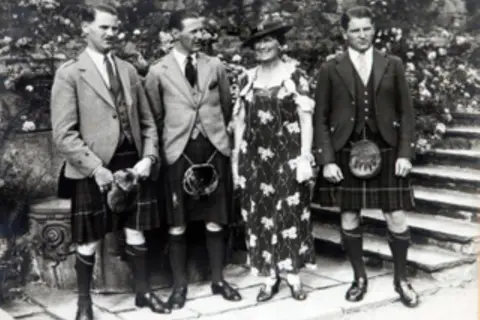 MacRobert Trust
MacRobert TrustThe losses experienced by the MacRobert family in World War Two were enormous but at the same time typical of the devastation caused by the war.
Lady Rachel MacRobert brought up her three sons in Aberdeenshire. Her eldest boy died in a civil flying accident in 1938 and her surviving sons were killed in 1941 while serving as RAF pilots.
Determined their names would not be forgotten, she donated the equivalent of £1m today to name a plane in their honour.
The Short Stirling bomber was called MacRobert's Reply and the tradition continues to this day, with numerous aircraft having since carried variations on the name.
The pain suffered through the loss of Lady Rachel's three boys must have been unbearable.
Alasdair died at the age of 26 in 1938.
His brother Roderic, who was also 26, was killed in action over Iraq in May 1941.
Just six weeks later, her youngest son, Iain, failed to return from a search and rescue operation from RAF Thornaby in North Yorkshire.
His body was never found. He was 24 years old.
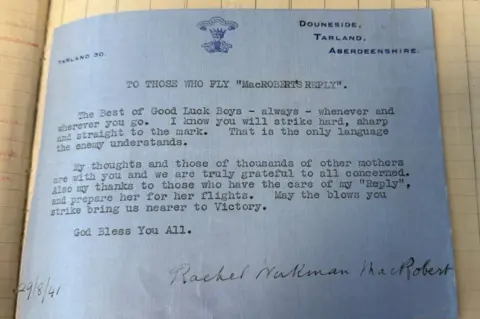
The first Short Stirling to go by the name MacRobert's Reply took to the air in September 1941 and Lady Rachel marked the occasion with a letter to the crew.
"The best of good luck boys - always - whenever and wherever you go. I know you will strike hard, sharp and straight to the mark. That is the only language the enemy understands," she wrote.
"My thoughts and those of thousands of other mothers are with you and we are truly grateful to all concerned. Also my thanks to those you have the care of my 'Reply', and prepare her for her flights.
"May the blows you strike bring us nearer to victory. God bless you all."
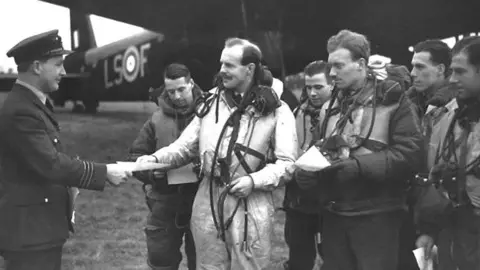 MacRobert Trust
MacRobert TrustLady Rachel was a geologist from a wealthy Massachusetts family.
She was the second wife of Sir Alexander MacRobert, a self-made millionaire from Aberdeen who founded the British India Corporation, and who had died in 1922.
The MacRobert Trust charity was set up following her death in 1954 and provides grants for charities across the UK.
Gillian Currie is its chief executive.
"The grief she must have felt would be unimaginable," she told BBC Scotland News.
"Only a couple of weeks after she learned of Iain's death, she wrote the letter to the Secretary of State for Air.
"In the letter, she wrote 'I have no more sons to wear the badge or carry on the fight but if I had 10 sons I know they would all have followed that line of duty'.
"I think those words really capture her character. She was such an independently minded and determined lady.
"Her MacRobert's Reply really shows that."
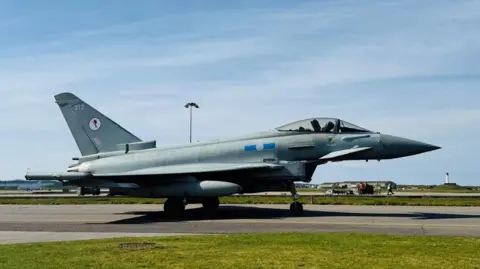
The first MacRobert's Reply's pilot was 22-year-old Peter Boggis, who went on to fly 15 missions in the aircraft over Europe.
His final mission in the aircraft was over the French port city of Brest, for which he was awarded the Distinguished Flying Cross for his bravery and skill.
A year later, Lady Rachel donated a further £20,000 to pay for four Hurricane fighters to join RAF operations in the Middle East.
They were named after herself, and her three sons.
The first "Sir Roderic" fighter - named after her middle son - was flown by Flight Lieutenant "Blondie" Walker. He flew 160 mission and was shot down three times.
Squadron Leader Clive Mitchell, from RAF Lossiemouth, explained how the base recently received his medals.
''They weren't mounted when we got them so he had never worn them," he said.
"He had two medals for bravery. A lot of the individuals who fought at the time were like that. It was let's get the job done, let's get home to the families. Let's get it all sorted out."
For a long time, XV Squadron flew MacRobert's Reply, with various Buccaneer and Tornado jets taking the name.
When XV Squadron was disbanded in 2017, the MacRobert legacy was carried on by VI Squadron.
A Typhoon Fighter jet, based at RAF Lossiemouth, currently has the name "Sir Roderic".
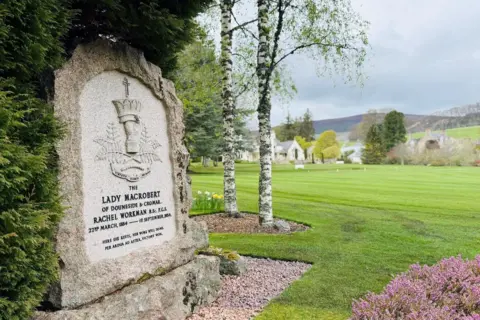
As well as honouring the MacRobert brothers, the various aircraft which have taken their names are a reminder of the many pilots who flew in them during World War Two and beyond.
"It's definitely still a source of inspiration," Squadron Leader Mitchell said.
"To do the job you're doing you need to understand what your predecessors have done.
"You can't understate the sacrifice that those people gave. They were the people for the time, but they were just normal people who went and did what was required."
When Lady Rachel died in 1954, there was an RAF flypast over her home at Douneside.
Eighty years on from VE Day, the current MacRobert aircraft is a reminder of the sacrifices made for victory and a mother's courageous call to carry on.
